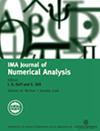Finite element methods for multicomponent convection-diffusion
IF 2.3
2区 数学
Q1 MATHEMATICS, APPLIED
引用次数: 0
Abstract
We develop finite element methods for coupling the steady-state Onsager–Stefan–Maxwell (OSM) equations to compressible Stokes flow. These equations describe multicomponent flow at low Reynolds number, where a mixture of different chemical species within a common thermodynamic phase is transported by convection and molecular diffusion. Developing a variational formulation for discretizing these equations is challenging: the formulation must balance physical relevance of the variables and boundary data, regularity assumptions, tractability of the analysis, enforcement of thermodynamic constraints, ease of discretization and extensibility to the transient, anisothermal and nonideal settings. To resolve these competing goals, we employ two augmentations: the first enforces the definition of mass-average velocity in the OSM equations, while its dual modifies the Stokes momentum equation to enforce symmetry. Remarkably, with these augmentations we achieve a Picard linearization of symmetric saddle point type, despite the equations not possessing a Lagrangian structure. Exploiting structure mandated by linear irreversible thermodynamics, we prove the inf-sup condition for this linearization, and identify finite element function spaces that automatically inherit well-posedness. We verify our error estimates with a numerical example, and illustrate the application of the method to nonideal fluids with a simulation of the microfluidic mixing of hydrocarbons.多成分对流扩散有限元方法
我们开发了将稳态 Onsager-Stefan-Maxwell (OSM) 方程与可压缩斯托克斯流耦合的有限元方法。这些方程描述了低雷诺数下的多组分流动,即在一个共同的热力学相中,不同化学物质的混合物通过对流和分子扩散进行流动。开发用于离散化这些方程的变分公式极具挑战性:公式必须平衡变量和边界数据的物理相关性、规则性假设、分析的可操作性、热力学约束的执行、离散化的简便性以及对瞬态、等温和非理想设置的可扩展性。为了解决这些相互竞争的目标,我们采用了两种增强方法:第一种增强方法在 OSM 方程中强制执行质量平均速度的定义,而第二种增强方法则修改斯托克斯动量方程以强制执行对称性。值得注意的是,尽管方程不具备拉格朗日结构,但通过这些增强,我们实现了对称鞍点类型的皮卡尔线性化。利用线性不可逆热力学规定的结构,我们证明了这种线性化的 inf-sup 条件,并确定了能自动继承好求解性的有限元函数空间。我们用一个数值例子验证了误差估计,并通过模拟碳氢化合物的微流体混合说明了该方法在非理想流体中的应用。
本文章由计算机程序翻译,如有差异,请以英文原文为准。
求助全文
约1分钟内获得全文
求助全文
来源期刊
CiteScore
5.30
自引率
4.80%
发文量
79
审稿时长
6-12 weeks
期刊介绍:
The IMA Journal of Numerical Analysis (IMAJNA) publishes original contributions to all fields of numerical analysis; articles will be accepted which treat the theory, development or use of practical algorithms and interactions between these aspects. Occasional survey articles are also published.

 求助内容:
求助内容: 应助结果提醒方式:
应助结果提醒方式:


